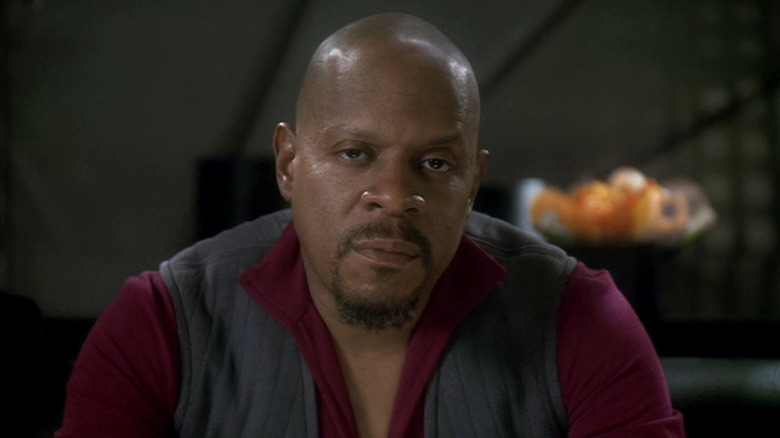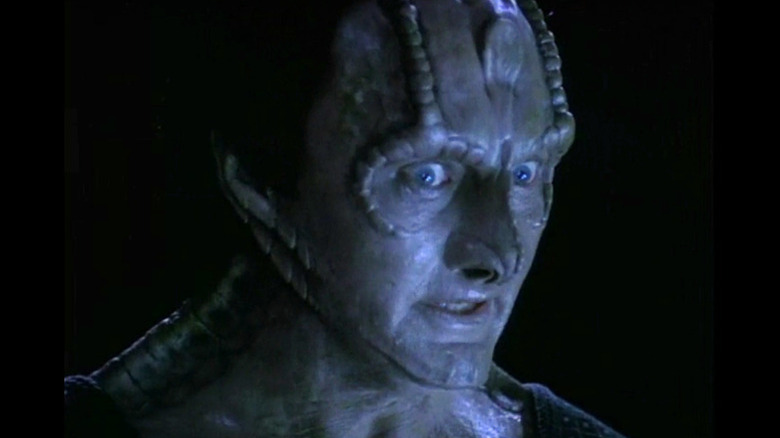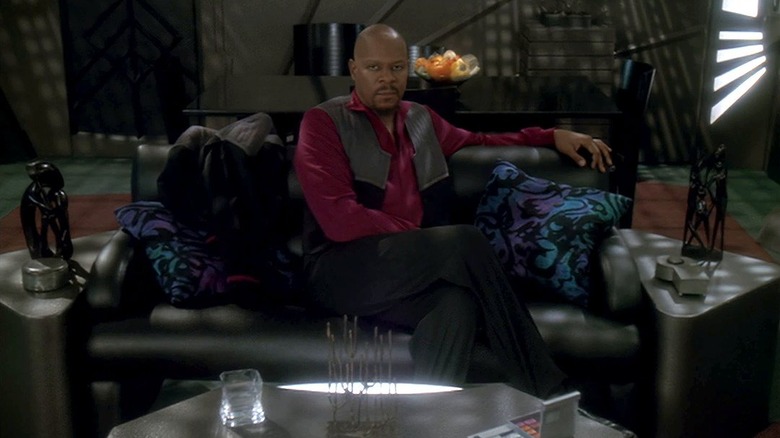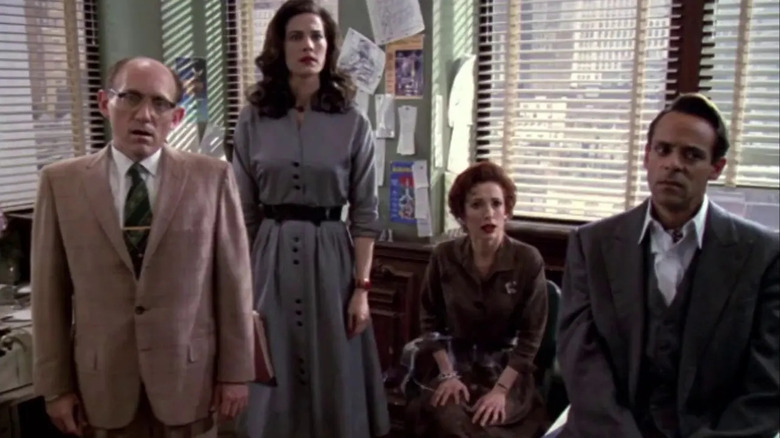5 Must-Watch Star Trek: Deep Space Nine Episodes
"Star Trek: Deep Space Nine" has often been treated as the weird stepchild of the "Star Trek" franchise because it deviated quite a bit from the standard, focusing on a space station in a fixed location and dealing heavily with aliens and moral ambiguity. No one was really "boldly going" much of anywhere, save for a few odd excursions through the nearby wormhole to see what was on the other side, which was wildly different from the exploration-based "Star Trek" shows that had come before (and would come after). For some fans, "Deep Space Nine" was too dark and concerned with war to be a proper "Star Trek" series, but in the time since the show's finale aired in 1999, many have come around to recognize it as something truly special.
As new fans discover this incredible science fiction series through streaming for the first time, it can be a little bit intimidating. After all, "Deep Space Nine" has over 170 episodes across seven seasons, which is a bit daunting to folks used to streaming seasons with 10 episodes or less. There are some episodes of the show everyone should see at least once, and we've compiled five of the very best here. While a few fan favorites didn't quite make the cut, like "Take Me Out to the Holosuite" or "It's Only a Paper Moon," that just means there's even more great "Deep Space Nine" for new fans to discover.
All seven seasons of "Star Trek: Deep Space Nine" are available to stream on Paramount+.
Duet - Season 1, Episode 19
One of the most challenging episodes of "Deep Space Nine" came early in its existence, in the Season 1 episode "Duet." The episode sees Bajoran major Kira Nerys (Nana Visitor), the first officer of the space station Deep Space Nine (DS9), forced to reckon with the actions of her past as a freedom fighter/terrorist when a Cardassian named Marritza (Harris Yulin) ends up at DS9 for treatment from an ailment he only could have caught while serving in a Cardassian death camp during the occupation of Bajor. It's believed that Marritza is actually Gul Darhe'el, who committed heinous war crimes against Bajorans and was complicit in their genocide, and he starts spouting fascist rhetoric when he's discovered.
Kira has to decide whether to take revenge on him herself, put him before the Bajoran war tribunal, or let it go, and he tells her that it doesn't matter either way because the past is the past. It's brutal watching Kira try to process the fact that there's no fixing the trauma done to her people, though the episode does offer a bit of hope with a second twist that shows us there is still hope even in the darkest of times. "Duet" is a great example of the kind of nuanced storytelling "Deep Space Nine" is capable of, and it does a fantastic job setting the stage for Major Kira's series-long arc as she helps her planet and people heal while also healing herself.
Trials and Tribble-ations - Season 5, Episode 6
Thankfully, there was quite a bit more to "Deep Space Nine" than just painful allegories that relate all too well to our own world — it could be a whole lot of fun, too! In Season 5, while many of the chief officers were transporting the Bajoran Orb of Time from Cardassia Prime back to Bajor via the zippy little warship the Defiant, they ended up accidentally going back in time and encountering the crew of the U.S.S. Enterprise under the command of Captain Kirk (William Shatner). The episode "Trials and Tribble-ations" uses footage from the classic "Star Trek: The Original Series" episode "The Trouble with Tribbles," with the DS9 crew inserted among them using some creative editing and special effects. They have to capture a Klingon assassin who turns a fuzzy little Tribble into a bomb, all without alerting the Enterprise crew to their existence among them.
"Trials and Tribble-ations" is chock full of "Star Trek" Easter eggs and fun little moments just for hardcore fans, but it also gives new context to one of the most popular episodes of "The Original Series" and makes some of those classic moments even funnier. It's not mind-blowing sci-fi, but it's tremendous fun that's still pure "Star Trek," and if the sight of an exploding Tribble doesn't make you laugh, you might be dead inside (or a Vulcan).
Empok Nor - Season 5, Episode 24
Before he was the creator of shows like "Pushing Daisies" and "Hannibal," Bryan Fuller was a writer on "Deep Space Nine," where he wrote the story that became the episode "Empok Nor" (with a teleplay by Hans Beimler). "Empok Nor" shows the flexibility of "Star Trek" and goes into full-on horror territory, following an expedition team led by Chief of Engineering Miles O'Brien (Colm Meaney) to retrieve a replacement part for DS9 from its sister space station, the abandoned Empok Nor (DS9's original name was Terok Nor).
Since Cardassians booby trap places before leaving them, they take along DS9's resident Cardassian tailor/spy, Garak (Andrew Robinson), with them, and while fighting the Cardassian soldiers frozen until the ship was boarded, he becomes affected by a psychotropic drug being pumped through the air that makes Cardassians even more bloodthirsty and xenophobic. He kills the other Cardassians and then turns on his own crew, and he's only stopped when Miles tricks him (and nearly kills him as a result).
"Empok Nor" is genuinely scary, showing off the kind of tension Fuller could create with his writing long before his killer "Hannibal" adaptation. Robinson (who played Larry Cotton in "Hellraiser") really gets to chew the scenery and revel in his character's dark side, and it's an intense little treat that works as a perfect standalone horror story.
In the Pale Moonlight - Season 6, Episode 19
While "Star Trek" creator Gene Roddenberry had been pretty explicit about the franchise he spawned not tackling the thorny topic of war, "Deep Space Nine" did exactly that with its long-running Dominion War arc, in which the entire quadrant was at risk of being overthrown by the villainous Dominion, run by the shapeshifting Founders, who had come through the wormhole from the Gamma quadrant. The Season 6 episode "In the Pale Moonlight" follows Captain Sisko (Avery Brooks) as he tries to reconcile the actions of his that were very un-Starfleet. In a "Star Trek" twist on the infamous Zimmerman Telegram that was used to help ensure the United States joined the Allied Powers during World War I, Sisko conspires with some of the shadiest characters on DS9 (including Garak) to trick the Romulans into joining the fight against the Dominion.
"In the Pale Moonlight" is a unique episode that features Sisko addressing the camera directly while recording his personal log (which he then deletes), and the morally ambiguous actions of the captain made it one seriously controversial "Deep Space Nine" episode when it aired. While it's a little more ethically complex than the average "Star Trek" outing, it provides the opportunity for audiences to interrogate their own feelings on a tricky situation and doesn't give any easy answers, making for an episode that's compelling on multiple rewatches.
Far Beyond the Stars - Season 6, Episode 13
"Star Trek" has regularly used its sci-fi setting to tell allegorical stories about our own world, but in the Season 6 episode "Far Beyond the Stars," it got pretty darn direct about racism and sexism in 1950s science fiction, commenting on those problems through today. The episode stands completely on its own because it's technically a dream world seen by Captain Sisko, where he lives through the experiences of sci-fi author Benny Russell. Avery Brooks directed the episode as well, and it's an incredible show of his talents both in front of and behind the camera, and the story is truly powerful. "Far Beyond the Stars" isn't afraid to tackle truly thorny topics like sexism in the workplace or police brutality, and while it doesn't have any of the fun holodeck antics or unique alien insight as some other great "Trek" episodes, its message matters far more than most.
After the magazine issue containing Russell's story is "pulped" by the editor instead of being released because they didn't want to publish a story featuring a Black protagonist, Russell has a nervous breakdown, crying out, "You can pulp a story but you cannot destroy an idea, don't you understand, that's ancient knowledge, you cannot destroy an idea." He sees a future where a Black man can be a hero, a future that partially came true when Brooks was cast as Sisko, the first Black "Star Trek" commander. "Far Beyond the Stars" is layered and brilliant, and it's not just one of the best "Deep Space Nine" episodes, but one of the best "Star Trek" episodes of all time.





